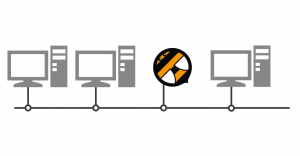First it was the cloud …
The SaaS revolution, which began in 1999 with Salesforce, has increased reliance on network connectivity and performance. In the 90s and early 2000s, most applications were desktop-based. Nowadays, SaaS applications rely on a web browser and network connectivity to be accessible. As result, without network connectivity, we cannot collaborate with our coworkers, access our documents and spreadsheets, or use other production tools.
You probably read about or were impacted by last Friday’s Google Docs outage. In that event, the outage was caused by a software update issue on the cloud service provider (BTW, has nobody at Google heard about the “no changes on Friday” policy?). Yet, the result was that many users around the world were not able to perform their day-to-day activities. I am sure that this problem affected many companies’ bottom line.
The Internet is full of statistics on the cost of network downtime, which is estimated to be $300,000 per hour according to Gartner. Also, according to the Aberdeen Group, network downtime costs medium size companies $800,000 and large ones $2,700,000 per year.
Characteristics of network monitoring from the end-user perspective
Network monitoring from the end-user perspective means using dedicated monitoring agents deployed at remote offices to continuously verify network connectivity, service availability, and application performance. In this scenario, distributed monitoring agents simulate, in a very simple way, a real user. They do so by continuously sending traffic over the network and performing transactions with the applications. Like with NetBeez, agents are connected to the access layer or wireless network, and utilize the same resources (switch port, bandwidth, application resources) as a real user.
Thanks to distributed agents that monitor the network and applications from the user perspective, you can quickly understand if the source of a problem is:
- the individual user (desktop or access port),
- the remote office’s Local Area Network (LAN),
- the overall Wide Area Network (WAN),
- the Internet Service Provider (ISP), or
- the application group or the Cloud Service Provider (CSP).
Reducing downtime and support costs
A platform that monitors the network from the end user perspective can help reduce the time to detection and repair of issues affecting SaaS users for two reasons:
- Automatic detection of remote network or application issues is faster than waiting for the end users to call to the help desk; with NetBeez, for example, agents can detect a problem with a remote application in less than 30 seconds.
- Performing troubleshooting on single dashboard rather than connecting to remote routers, switches, and workstation to collect the information needed to identify the smoking gun, is time efficient and requires also fewer skilled operators.
As result, users experience less downtime while IT support is able to troubleshoot problems faster and, oftentimes, without the direct involvement of the end users. These efficiencies translate into cost savings, less frustration, and improved customer-facing services.
If you want to learn more about network monitoring from the end-user perspective, and see how much savings your company can introduce, don’t hesitate to schedule a demo with me. I would be happy to learn more about your network and how you currently solve such issues.






